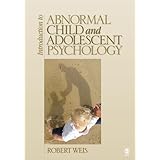
Average Reviews:

(More customer reviews)This book provides a nice introduction to abnormal child psychology. I especially like the way it integrates research with examples of real-world practice. The introductory chapters focus mostly on the principles of developmental psychopathology, ethics in research and practice with children, assessment, and diagnosis. Later chapters focus on specific disorders. Each chapter presents several "case studies" and shows how clinicians might use empirically supported treatments to help children with that specific disorder. Some of the things I liked about this book was that it has specific sections on adolescent substance use problems and pediatric bipolar disorder. I also liked the fact that it gives detailed descriptions of both psychosocial and pharmaceutical treatments and summaries of the research studies that support each treatment's use. Nothing is dumbed-down, but neither is it too difficult to understand. One weakness is a lack of emphasis on pediatric psychology. Still, a good book for undergraduates or beginning graduate students.
Click Here to see more reviews about: Introduction to Abnormal Child and Adolescent Psychology
'This text addresses the basics of developmental psychopathology in a clear manner, with enough detail to facilitate a real understanding of the concepts and their relevance to clinical work with children." --Christie P. Karpiak, University of Scranton
This introductory undergraduate text on child and adolescent psychopathology adopts a developmental psychopathology approach to understanding child disorders. The author examines the emergence of disorders over time, pays special attention to risk and protective factors that influence developmental processes and trajectories, and examines child psychopathology in the context of normal development. The author has four main goals: to show students why an understanding of child psychopathology and its treatment might be important to them as future psychologists, social workers, educators, and/or parents; to introduce students to the developmental psychopathology perspective and how it can help organize understanding of childhood disorders; to help students appreciate the interdependence of psychological research and clinical practice; and to engage students in higher-level thinking necessary to analyze information, critically evaluate ideas, and create solutions to real-world problems based on empirically validated findings.
Key Features
Links research with clinical practice via a focus on evidence-based therapies for childhood disorders, balancing solid empirical science and clinical insights and thus helping students filter clinically valuable findings from those lacking utility
Emphasizes the developmental perspective to better understand psychopathology, with use of normal development as a lens through which to view abnormal behavior or emotional problems
Provides case studies and real-life examples in each chapter, allowing the student to understand how the material relates to specific situations
Incorporates assessment methods into specific content modules rather than isolating assessment as a separate and discrete chapter
Utilizes smaller, more focused modules to allow for greater flexibility for instructors and students and to avoid the problem (seen in other texts) of lumping dissimilar problems into longer chapters
Offers end-of-chapter review questions that help students apply, analyze, and evaluate the information in the chapter, requiring them to critically think about the material
Includessuggested additional readings describing etiological models, empirical studies, or treatment approaches, as well as current research articles.
Click here for more information about Introduction to Abnormal Child and Adolescent Psychology

0 comments:
Post a Comment